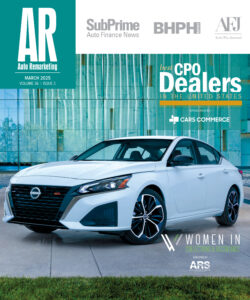Webb: Manheim Index Reaches Highest Level Ever

Never before has the Manheim Used Vehicle Value Index climbed this high. It has also been more than a year since the reading rose this much in a single month.
Manheim’s Tom Webb reported the October index spiked to 122.9 after three consecutive months where it remained nearly flat. The September mark was 118.9, meaning the index moved up by four points. Not since a five-point move in May to June of last year (109.1 to 114.1) has this Manheim statistic posted such a dramatic change so quickly.
Webb said wholesale used-vehicle prices (on a mix, mileage, and seasonally adjusted basis) moved up markedly in October. He indicated all of the gain was the result of seasonal adjustments, however unadjusted prices declined 1.2 percent during the month.
The October index reading also represented a 4.7-percent increase from a year ago.
And for reference, the lowest point the Manheim index has ever been is 98.0 in December of 2008.
“The simple summation of October auction results (regardless of how analyzed) is that wholesale pricing remained strong in an environment of limited supply and enthusiastic (but strategic) bidding,” Webb surmised in his commentary late last week.
“That climate has existed throughout 2010 and will likely continue well into 2011,” he continued.
Moving along to a discussion about vehicle segments, Webb indicated low supplies and stable demand have pushed pickup prices higher. He noted October pickup truck prices increased 10.1 percent year-over-year. Beating that mark were prices for vans, which Webb said climbed 10.6 percent in October.
“Full-size pickups and vans have been the strongest price performers over the past year,” Webb stated. “They have also had the biggest reduction in available supply at auction.”
While not reaching double digits, Webb spotted that three other vehicle segments posted sizable year-over-year price advancements in October. Those segments included SUV/CUV (up 5.6 percent), compact cars (up 3.7 percent) and midsize cars (up 3.7 percent).
Webb even noticed luxury car prices managed to edge up 0.2 percent in October.
“Although luxury cars have had the weakest price performance over the past year, their price performance over both the past three and six months has been better than the overall market,” Webb explained.
Elsewhere, the Manheim economist discovered off-rental risk units showed strong and steady pricing.
“The average price of a rental risk unit sold at auction showed a decline in October versus September (the normal seasonal pattern), but remained well above the year-ago level,” Webb stated.
Specifically, he indicated average mileage at time of sale for these units was 36,740. That figure was above September’s level but below the year-ago average of 40,280.
Webb also mentioned that looking at the overall wholesale picture, middle price points showed the greatest strength in October.
“An analysis of changes in average mileage by price tier suggests that the strongest price performance was achieved by vehicles in the $8,000 to $10,000 range, followed closely by vehicles in the $5,000 to $8,000 range,” he calculated.
“Vehicles both above and below these price points fared less well in October,” Webb added.
Despite the October index and wholesale price activity, Webb reiterated used-vehicle operations are continuing to produce dealer profits.
The Manheim economist cited CNW Research information that determined used-vehicle retail sales by dealers increased 5 percent during the third quarter versus a year ago. Webb also mentioned preliminary numbers put October’s sales gain at 39 percent as compared to last year, which he pointed out still was influenced by Cash for Clunkers.
Within total used-vehicle sales, Webb also highlighted information from Autodata Corp. that determined sales of certified pre-owned units rose 21.5 percent in September and 3.1 percent during the first nine months of 2010.
Furthermore, Webb highlighted results from the seven publicly traded dealership groups that showed same-store used-vehicle retail sales growing 12.5 percent in the third quarter. He also said their sales-weighted gains in the first and second quarters were 13.4 percent and 12.2 percent, respectively.
“By far and away, 2010 has represented their strongest sales improvement ever,” Webb declared.
“In addition, gross margins have held steady despite higher wholesale prices. Couple that with quick inventory turns and improved F&I opportunities, the result has been record used-vehicle department profits,” he went on to say.
Webb wrapped up his monthly commentary by indicating new-vehicle sales suggest a solidifying recovery.
Because the seasonally adjusted annual rate (SAAR) of new-vehicle sales in October topped the 12 million mark, Webb noted how it represented the fastest non Cash for Clunkers month since September 2008.
“October’s SAAR was a continuation of the steady (albeit modest) upward trend that started in early 2009,” Webb surmised.
“Off of today’s low base, new vehicle sales will make further significant unit and percentage gains in 2011,” he concluded.

 View The Latest Edition
View The Latest Edition

